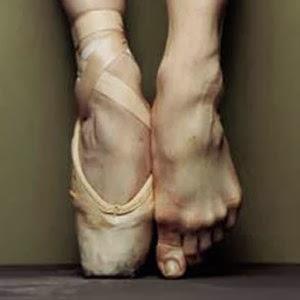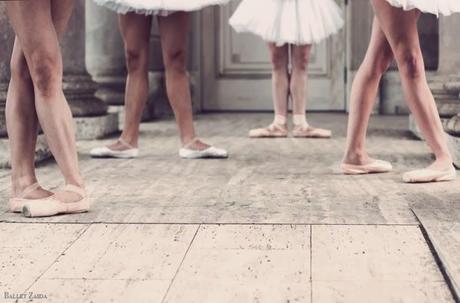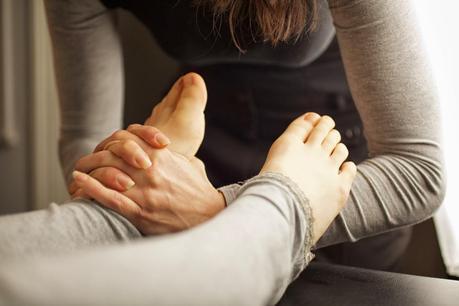classicchicfashions.BlogSpot.com
praisehimwithadance.com
facebook.com/praisehimwithadance As ballet dancers, we all know how important it is to have our feet in good shape. Carrying an entire body on a handful of little bones and ligaments in our toes, isn't something our bodies were designed to do. But how exactly can we better care for these hard working phalanges? Amanda can tell you.
Taking Care of Your Feet
How to Prevent Bunions
Bunions are caused by inflammation of the joint in the big toe. The inflammation causes an abnormal enlargement of the joint at the base of the toe. The first metatarsal is displaced and can move into or under the other four metatarsals, causing it to project.
Dancers who are en pointe are usually the ones who have the problem of bunions. This is because the box pushes all of your toes together, creating an unnatural position for them. Dancers who are using soft ballet shoes do not run into this problem because of the looser material.
One way to prevent bunions is by using toe spacers. Toe spacers allow a space in between the big toe and second toe preventing some of the ‘squishing.’ You can also do some simple tension exercises that will strengthen the muscles that keep the toes in place.
· Put a thick rubber band on both of your big toes. Without moving your feet, start moving your big toes away from each other. Repeat four times.
· Start with your feet flat on the floor. Start gripping your toes making a ‘bridge’ with your feet. This will strengthen your arch as well as your toes. Repeat five times.
Blister Prevention
Blisters occur when there is a constant rubbing against the exposed skin and when there is constant moisture to that same area. The friction causes the layers of skin below the epidermal layer to tear. A clear liquid is then excreted to help protect the skin underneath. Popped blisters can get infected and cause more of a problem than if they were left alone. Even though you might get the urge to pop you blister to get rid of it, stop! The liquid underneath actually prevents infection and is there to heal the skin underneath faster. The best thing to do is to avoid blisters all together.
Make sure your dance shoes (and everyday shoes) fit well and form to your feet. If they are too loose, they can cause friction between the shoe and your foot creating blisters. You also don’t want them to be too tight.
 Every dancer has different spots on their feet where blisters tend to reappear, especially if you are en pointe. Protect your feet with toe tape, gel toe covers, or lamb’s wool to keep your toes from rubbing against your shoes. When you take your shoes off after class, take notice of the red spots on your feet. Those spots are the ones that will most likely get a blister.
Every dancer has different spots on their feet where blisters tend to reappear, especially if you are en pointe. Protect your feet with toe tape, gel toe covers, or lamb’s wool to keep your toes from rubbing against your shoes. When you take your shoes off after class, take notice of the red spots on your feet. Those spots are the ones that will most likely get a blister.When you dance, your feet sweat. There is no way to prevent it. If your feet are constantly in an environment where there is moisture, blisters can occur. Make sure you choose toe pads that will absorb the sweat so that your feet are dryer, such as lamb’s wool, Ouch Pouch, or foam. Gel toe pads tend to trap the sweat inside. If you do choose to use gel, however, make sure you wash your feet in between performances so that they stay dry.
If you do develop a blister in the middle of class or during the week, make sure you have items such as Antibacterial ointment, blister bandages, foot powder, and tights. Blisters aren’t always preventable, but it is a good idea to try to keep them away as much as possible. Dr. Scholl’s blister Band-Aids provide a thick covering over the blister to prevent it from popping during class.
Protecting Your Feet
Logical Shoe Choices—
Flip-Flops are usually what dancers choose to wear when they need to remove their shoes quickly. It is also very popular to wear them in the summer when you want your toes to breathe a little. The downsides to flip-flops are many and might make you think twice before wearing them every day. When you wear flip-flops, your toes have to grip tight in order to keep them on. There have also been links between flip-flops and tendonitis. The constant gripping of the toes tires the tendons out causing inflammation. In addition, they don’t provide any support. The arch tends to drop because there is no arch support built into the shoe. The great thing about this day and age is that more and more shoe companies are coming out with more supportive flip-flops. So before you decide to pick up a pair of flat flip-flops, try the new ones with arch support. They will make your feet feel so much better in the end.
If you are like me, high heels are your first choice for a fancy dinner, party, or event. High heels, however can cause problems with your calves, Achilles tendon, and toes. The constant position of being in ‘releve’ can shorten your muscles and make them contract giving you less motion in your calves and feet. They can also cause a lot of stress and contract the mobility of your joints and your Achilles tendon. When you shop for your high heels make sure they fit and are comfortable. “One test is to stand on the floor in the shoes with your knees straight, not locked. Raise yourself on your toes so there’s at least an inch of space under your heels. If you can’t do that, the heels are too high and you shouldn’t wear them,” says Stacy Barrows, PT, at Century City Physical Therapy in Los Angeles.
To give your feet a break between classes, sneakers or any stiff shoe are your best choices. They give your toes a rest by allowing them to just rest inside the shoe without gripping. Make sure your shoe of choice has an arch support to avoid flat feet. The best places to get arch supportive shoes are Payless and footsmart.com. They both provide a wide selection of comfortable shoes in all sorts of styles. My favorite brands are Airwalk, Dr. Scholl’s, and Aerosoles.
Pointe Shoes—
It is so important that dancers who are en pointe properly protect their feet while dancing. Use proper padding such as toe tape, toe wrap, pointe pads, toe separators, and lamb’s wool. It is also important to have band aids available for any injuries. Proper padding and protection will help your feet in the end. I recommend Pillows for Pointe Gel Tip Toe Pillows, Bunheads Ouch Pouch Jr. toe pads, Pillows for Pointe Lamb’s Wool, Body Wrappers Arch Enhancer Pads, Bunheads Toe Tape, and Gaynor Minden Toe Wrap Foam Tape.

Exercises and Relaxation
When you are done with classes, your feet could use a little TLC. Here are some exercises that you can do to stretch them out and relax the muscles. There are also some great at-home spa treatments that you can treat your feet to after a tough day of rehearsals.
The Exercises—
· Put your feet flat on the floor. Lift your big toe up the stretch the muscle under your arch. The idea is to keep all of your other toes on the floor as you are doing this. Lower your toe back down to the floor with some tension. Repeat ten times.
· Place your hands on the wall for support. Put the balls of your feet on the wall keeping your heel stationary on the floor. Bring your knee toward the wall slowly and hold for 30 seconds. Stop if you start to feel any pain. Repeat for three repetitions.
· Tie a theraband around your ankles and around the barre. Move away from the barre to create tension. Raise onto half pointe keeping your ankles over your knees. Repeat twenty times making sure you’re not rolling out.
The muscle in the arch of your foot is called the tibialis posterior.It starts at the lower end of the calf and connects to the bone of the arch. When the muscle gets tired, the arch will drop. To strengthen this muscle, you can perform standing calf raises. Walking barefoot is also very good for your feet. Walking on sand will allow your toes to spread, stretching them out and massaging the muscles. Another way to stretch the tibialis posterior is to perform rotation exercises.

· Tie a theraband around the barre and wrap it around your foot. Sit on a chair parallel to the barre. Turn your toes inward creating a tension in your ankle and arch. Repeat ten times.
· Clean you room with your feet! It sounds weird but it is very effective. Instead of picking things up off the floor with your hands, do it with your feet. It strengthens your toe muscles and actually helps with your motor skills.
At-Home Spa for Your Feet—
The constant jumping, pressure, stretching, and standing on your toes can make your feet look and feel very tired and sore. To rejuvenate your feet after a tough rehearsal, give them a warm bath. Fill a tub or large bowl with warm to hot water. Drop about 10 drops of lavender (relaxation), peppermint (rejuvenation), or citrus (awakening) oil in the water. You can also put a ½ cup of Epsom salts in for detox. You can get essential oils at mountainroseherbs.comalong with any other Aromatherapy and Body Care products.
Massage your feet to release the tension in your muscles. Use a body butter or massage oil and work from your heel to your toes. Don’t forget to massage the top of your feet and your ankles, they need it too! To get the full effect, try these massaging techniques.
· On the heel, use medium to heavy pressure with your thumbs. Move one thumb up and the other down. Repeat, always making sure you have one thumb up and the other down.
· Make circles around your ankles with your fingers.
· Use your knuckles to knead the arch. It tends to hold a lot of tension so use heavy pressure but be gentle.
· Massage in between each toe. Then massage each pad of the toe with medium to light pressure.
· On either side of the foot, use a pulling motion. Repeat ten times alternating hands with the pulling.
· Massage the balls of your feet with your thumbs with the same motion as with the heel massage.
· Massage the Achilles tendon and work up your calf releasing any tension.
If you are really sore, you can rub Dr. Christopher’s Complete Bone & Tissue into your skin. It will penetrate deep to heal and soothe the muscles and bones. It’s much more effective than any pain killer. You can purchase this product on drchristophersherbs.com. It works best when applied twice a day especially after a tough day of rehearsals.
Taking Care of Your Feet chapter taken from A Dancer’s Diary by Amanda E. Howard
Wonderful article. Thanks, Amanda!
Post comments and questions below or e-mail me at: [email protected].
Stay tuned for Wednesday's Dancer S.O.S. advice column, and don't forget next Monday we have a famous guest interviewee!
Rhiannon -
